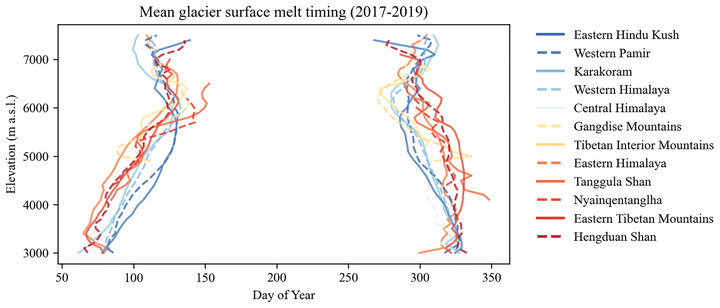Mapping seasonal glacier melt across the Hindu Kush Himalaya with time series synthetic aperture radar (SAR)

Abstract
Current observational data on Hindu Kush Himalayas (HKH) glaciers are sparse, and characterizations of seasonal melt dynamics are limited. Time series synthetic aperture radar (SAR) imagery enables detection of reach-scale glacier melt characteristics across continents. We analyze C-band Sentinel-1 A/B SAR time series data, comprised of 32 741 Sentinel-1 A/B SAR images, and determine the duration of seasonal glacier melting for 105 432 mapped glaciers (83 102 km2 glacierized area, defined using optical observations) in the HKH across the calendar years 2017–2019. Melt onset and duration are recorded at 90 m spatial resolution and 12 d temporal repeat. All glacier areas within the HKH exhibit some degree of melt. Melt signals persist for over two-thirds of the year at elevations below 4000 m a.s.l. and for nearly half of the calendar year at elevations exceeding 7000 m a.s.l. Retrievals of seasonal melting span all elevation ranges of glacierized area in the HKH region, extending greater than 1 km above the maximum elevation of an interpolated 0 ∘C summer isotherm and at the top of Mount Everest, where in situ data and surface energy balance models indicate that the Khumbu Glacier is melting at surface air temperatures below −10 ∘C. Sentinel-1 melt retrievals reflect broad-scale trends in glacier mass balance across the region, where the duration of melt retrieved in the Karakoram is on average 16 d less than in the eastern Himalaya sub-region. Furthermore, percolation zones are apparent from meltwater retention indicated by delayed refreeze. Time series SAR datasets are suitable to support operational monitoring of glacier surface melt and the development and assessment of surface energy balance models of melt-driven ablation across the global cryosphere.